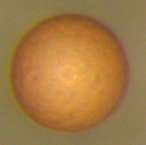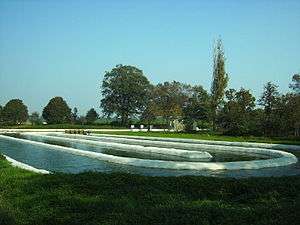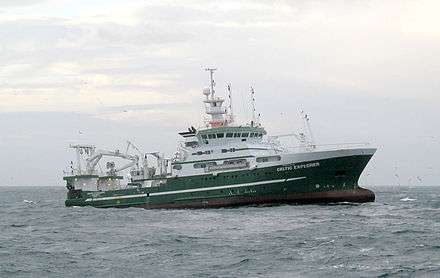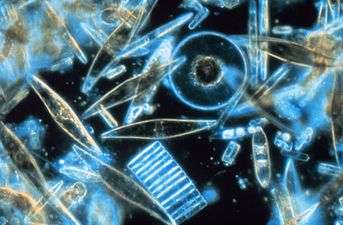Algaculture
Algaculture is a form of aquaculture involving the farming of species of algae.
The majority of algae that are intentionally cultivated fall into the category of microalgae (also referred to as phytoplankton, microphytes, or planktonic algae). Macroalgae, commonly known as seaweed, also have many commercial and industrial uses, but due to their size and the specific requirements of the environment in which they need to grow, they do not lend themselves as readily to cultivation (this may change, however, with the advent of newer seaweed cultivators, which are basically algae scrubbers using upflowing air bubbles in small containers).
Commercial and industrial algae cultivation has numerous uses, including production of food ingredients such as omega-3 fatty acids or natural food colorants and dyes, food, fertilizer, bioplastics, chemical feedstock (raw material), pharmaceuticals, and algal fuel, and can also be used as a means of pollution control.
Growing, harvesting, and processing algae
Monoculture
Most growers prefer monocultural production and go to considerable lengths to maintain the purity of their cultures. With mixed cultures, one species comes to dominate over time and if a non-dominant species is believed to have particular value, it is necessary to obtain pure cultures in order to cultivate this species. Individual species cultures are also needed for research purposes.
A common method of obtaining pure cultures is serial dilution. Cultivators dilute either a wild sample or a lab sample containing the desired algae with filtered water and introduce small aliquots (measures of this solution) into a large number of small growing containers. Dilution follows a microscopic examination of the source culture that predicts that a few of the growing containers contain a single cell of the desired species. Following a suitable period on a light table, cultivators again use the microscope to identify containers to start larger cultures.
Another approach is to use a special medium which excludes other organisms, including invasive algae. For example, Dunaliella is a commonly grown genus of microalgae which flourishes in extremely salty water that few other organisms can tolerate.
Alternatively, mixed algae cultures can work well for larval mollusks. First, the cultivator filters the sea water to remove algae which are too large for the larvae to eat. Next, the cultivator adds nutrients and possibly aerates the result. After one or two days in a greenhouse or outdoors, the resulting thin soup of mixed algae is ready for the larvae. An advantage of this method is low maintenance.
Growing algae

Water, carbon dioxide, minerals and light are all important factors in cultivation, and different algae have different requirements. The basic reaction for algae growth in water is carbon dioxide + light energy + water = glucose + oxygen + water.[1] This is called autotrophic growth. It is also possible to grow certain types of algae without light, these types of algae consume sugars (such as glucose). This is called heterotrophic growth.
Temperature
The water must be in a temperature range that will support the specific algal species being grown mostly between 15 and 35 degrees C.
Light and mixing
In a typical algal-cultivation system, such as an open pond, light only penetrates the top 3 to 4 inches (76–102 mm) of the water, though this depends on the algae density. As the algae grow and multiply, the culture becomes so dense that it blocks light from reaching deeper into the water. Direct sunlight is too strong for most algae, which can use only about 1⁄10 the amount of light they receive from direct sunlight; however, exposing an algae culture to direct sunlight (rather than shading it) is often the best course for strong growth, as the algae underneath the surface get more light.
To use deeper ponds, growers agitate the water, circulating the algae so that it does not remain on the surface. Paddle wheels can stir the water and compressed air coming from the bottom lifts algae from the lower regions. Agitation also helps prevent over-exposure to the sun.
Another means of supplying light is to place the light in the system. Glow plates made from sheets of plastic or glass and placed within the tank offer precise control over light intensity, and distribute it more evenly. They are seldom used, however, due to high cost.
Odor and oxygen
The odor associated with bogs, swamps, indeed any stagnant waters, can be due to oxygen depletion caused by the decay of deceased algal blooms. Under anoxic conditions, the bacteria inhabiting algae cultures break down the organic material and produce hydrogen sulfide and ammonia which causes the odor. This hypoxia often results in the death of aquatic animals. In a system where algae is intentionally cultivated, maintained, and harvested, neither eutrophication nor hypoxia are likely to occur.
Some living algae and bacteria, also produce odorous chemicals, particularly certain (cyanobacteria) (previously classed as blue-green algae) such as Anabaena. The most well-known of these odor-causing chemicals are MIB (2-methylisoborneol) and geosmin. They give a musty or earthy odor that can be quite strong. Eventual death of the cyanobacteria releases additional gas that is trapped in the cells. These chemicals are detectable at very low levels, in the parts per billion range, and are responsible for many "taste and odor" issues in drinking water treatment and distribution.[2] Cyanobacteria can also produce chemical toxins that have been a problem in drinking water.
Nutrients
Nutrients such as nitrogen (N), phosphorus (P), and potassium (K) serve as fertilizer for algae, and are generally necessary for growth. Silica and iron, as well as several trace elements, may also be considered important marine nutrients as the lack of one can limit the growth of, or productivity in, a given area. Carbon dioxide is also essential; usually an input of CO2 is required for fast-paced algal growth. These elements must be dissolved into the water, in bio-available forms, for algae to grow.
Pond and bioreactor cultivation methods
Algae can be cultured in open ponds (such as raceway-type ponds and lakes) and photobioreactors. Raceway ponds may be less expensive.
Open ponds

Raceway-type ponds and lakes are open to the elements. Open ponds are highly vulnerable to contamination by other microorganisms, such as other algal species or bacteria. Thus cultivators usually choose closed systems for monocultures. Open systems also do not offer control over temperature and lighting. The growing season is largely dependent on location and, aside from tropical areas, is limited to the warmer months.
Open pond systems are cheaper to construct, at the minimum requiring only a trench or pond. Large ponds have the largest production capacities relative to other systems of comparable cost. Also, open pond cultivation can exploit unusual conditions that suit only specific algae. For instance, Dunaliella salina grow in extremely salty water; these unusual media exclude other types of organisms, allowing the growth of pure cultures in open ponds. Open culture can also work if there is a system of harvesting only the desired algae, or if the ponds are frequently re-inoculated before invasive organisms can multiply significantly. The latter approach is frequently employed by Chlorella farmers, as the growth conditions for Chlorella do not exclude competing algae.
The former approach can be employed in the case of some chain diatoms since they can be filtered from a stream of water flowing through an outflow pipe. A "pillow case" of a fine mesh cloth is tied over the outflow pipe allowing other algae to escape. The chain diatoms are held in the bag and feed shrimp larvae (in Eastern hatcheries) and inoculate new tanks or ponds.
Enclosing a pond with a transparent or translucent barrier effectively turns it into a greenhouse. This solves many of the problems associated with an open system. It allows more species to be grown, it allows the species that are being grown to stay dominant, and it extends the growing season – if heated, the pond can produce year round. Open race way ponds were used for removal of lead using live Spirulina (Arthospira) sp.[3]
Photobioreactors
Algae can also be grown in a photobioreactor (PBR). A PBR is a bioreactor which incorporates a light source. Virtually any translucent container could be called a PBR; however, the term is more commonly used to define a closed system, as opposed to an open tank or pond.
Because PBR systems are closed, the cultivator must provide all nutrients, including CO
2.
A PBR can operate in "batch mode", which involves restocking the reactor after each harvest, but it is also possible to grow and harvest continuously. Continuous operation requires precise control of all elements to prevent immediate collapse. The grower provides sterilized water, nutrients, air, and carbon dioxide at the correct rates. This allows the reactor to operate for long periods. An advantage is that algae that grows in the "log phase" is generally of higher nutrient content than old "senescent" algae. Algal culture is the culturing of algae in ponds or other resources. Maximum productivity occurs when the "exchange rate" (time to exchange one volume of liquid) is equal to the "doubling time" (in mass or volume) of the algae.
Different types of PBRs include:
- Tanks
- Polyethylene sleeves or bags
- Glass or plastic tubes.
Harvesting

Algae can be harvested using microscreens, by centrifugation, by flocculation[4] and by froth flotation.
Interrupting the carbon dioxide supply can cause algae to flocculate on its own, which is called "autoflocculation".
"Chitosan", a commercial flocculant, more commonly used for water purification, is far more expensive. The powdered shells of crustaceans are processed to acquire chitin, a polysaccharide found in the shells, from which chitosan is derived via de-acetylation. Water that is more brackish, or saline requires larger amounts of flocculant. Flocculation is often too expensive for large operations.
Alum and ferric chloride are other chemical flocculants.
In froth flotation, the cultivator aerates the water into a froth, and then skims the algae from the top.[5]
Ultrasound and other harvesting methods are currently under development.[6][7][8]
Oil extraction
Algae oils have a variety of commercial and industrial uses, and are extracted through a variety of methods. Estimates of the cost to extract oil from microalgae vary, but are likely to be around three times higher than that of extracting palm oil.[9]
Physical extraction
In the first step of extraction, the oil must be separated from the rest of the algae. The simplest method is mechanical crushing. When algae is dried it retains its oil content, which then can be "pressed" out with an oil press. Different strains of algae warrant different methods of oil pressing, including the use of screw, expeller and piston. Many commercial manufacturers of vegetable oil use a combination of mechanical pressing and chemical solvents in extracting oil. This use is often also adopted for algal oil extraction.
Osmotic shock is a sudden reduction in osmotic pressure, this can cause cells in a solution to rupture. Osmotic shock is sometimes used to release cellular components, such as oil.
Ultrasonic extraction, a branch of sonochemistry, can greatly accelerate extraction processes. Using an ultrasonic reactor, ultrasonic waves are used to create cavitation bubbles in a solvent material. When these bubbles collapse near the cell walls, the resulting shock waves and liquid jets cause those cells walls to break and release their contents into a solvent.[10] Ultrasonication can enhance basic enzymatic extraction. The combination "sonoenzymatic treatment" accelerates extraction and increases yields.[11]
Chemical extraction
Chemical solvents are often used in the extraction of the oils. The downside to using solvents for oil extraction are the dangers involved in working with the chemicals. Care must be taken to avoid exposure to vapors and skin contact, either of which can cause serious health damage. Chemical solvents also present an explosion hazard.[12]
A common choice of chemical solvent is hexane, which is widely used in the food industry and is relatively inexpensive. Benzene and ether can also separate oil. Benzene is classified as a carcinogen.
Another method of chemical solvent extraction is Soxhlet extraction. In this method, oils from the algae are extracted through repeated washing, or percolation, with an organic solvent such as hexane or petroleum ether, under reflux in a special glassware.[13] The value of this technique is that the solvent is reused for each cycle.
Enzymatic extraction uses enzymes to degrade the cell walls with water acting as the solvent. This makes fractionation of the oil much easier. The costs of this extraction process are estimated to be much greater than hexane extraction.[14] The enzymatic extraction can be supported by ultrasonication. The combination "sonoenzymatic treatment" causes faster extraction and higher oil yields.[11]
Supercritical CO2 can also be used as a solvent. In this method, CO2 is liquefied under pressure and heated to the point that it becomes supercritical (having properties of both a liquid and a gas), allowing it to act as a solvent.[15][16]
Other methods are still being developed, including ones to extract specific types of oils, such as those with a high production of long-chain highly unsaturated fatty acids.[6][7]
Algal culture collections
Specific algal strains can be acquired from algal culture collections, with over 500 culture collections registered with the World Federation for Culture Collections.[17]
Uses of algae
Food
Several species of algae are raised for food.
- Purple laver (Porphyra) is perhaps the most widely domesticated marine algae.[18] In Asia it is used in nori (Japan) and gim (Korea). In Wales, it is used in laverbread, a traditional food, and in Ireland it is collected and made into a jelly by stewing or boiling. Preparation also can involve frying or heating the fronds with a little water and beating with a fork to produce a pinkish jelly. Harvesting also occurs along the west coast of North America, and in Hawaii and New Zealand.
- Dulse (Palmaria palmata) is a red species sold in Ireland and Atlantic Canada. It is eaten raw, fresh, dried, or cooked like spinach.
- Spirulina (Arthrospira platensis) is a blue-green microalgae with a long history as a food source in East Africa and pre-colonial Mexico. Spirulina is high in protein and other nutrients, finding use as a food supplement and for malnutrition. Spirulina thrives in open systems and commercial growers have found it well-suited to cultivation. One of the largest production sites is Lake Texcoco in central Mexico.[19] The plants produce a variety of nutrients and high amounts of protein. Spirulina is often used commercially as a nutritional supplement.[20][21]
- Chlorella, another popular microalgae, has similar nutrition to spirulina. Chlorella is very popular in Japan. It is also used as a nutritional supplement with possible effects on metabolic rate.[22] Some allege that Chlorella can reduce mercury levels in humans (supposedly by chelation of the mercury to the cell wall of the organism).[23]
- Irish moss (Chondrus crispus), often confused with Mastocarpus stellatus, is the source of carrageenan, which is used as a stiffening agent in instant puddings, sauces, and dairy products such as ice cream. Irish moss is also used by beer brewers as a fining agent.
- Sea lettuce (Ulva lactuca), is used in Scotland where it is added to soups and salads. Dabberlocks or badderlocks (Alaria esculenta) is eaten either fresh or cooked in Greenland, Iceland, Scotland and Ireland.
- Aphanizomenon flos-aquae is a cyanobacteria similar to spirulina, which is used as a nutritional supplement.
- Extracts and oils from algae are also used as additives in various food products.[24] The plants also produce Omega-3 and Omega-6 fatty acids, which are commonly found in fish oils, and which have been shown to have positive health benefits.[25]
- Sargassum species are an important group of seaweeds. These algae have many phlorotannins.
- Cochayuyo (Durvillaea Antarctica) is eaten in salads and ceviche in Peru and Chile.
Fertilizer and agar
For centuries seaweed has been used as fertilizer. It is also an excellent source of potassium for manufacture of potash and potassium nitrate.
Both microalgae and macroalgae are used to make agar.[26][27][28]
Pollution control
With concern over global warming, new methods for the thorough and efficient capture of CO2 are being sought out. The carbon dioxide that a carbon-fuel burning plant produces can feed into open or closed algae systems, fixing the CO2 and accelerating algae growth. Untreated sewage can supply additional nutrients, thus turning two pollutants into valuable commodities.[29]
Algae cultivation is under study for uranium/plutonium sequestration and purifying fertilizer runoff.
Energy production
Business, academia and governments are exploring the possibility of using algae to make gasoline, diesel and other fuels. Algae itself may be used as a biofuel, and additionally be used to create hydrogen. See Algae fuel.
Other uses
Chlorella, particularly a transgenic strain which carries an extra mercury reductase gene, has been studied as an agent for environmental remediation due to its ability to reduce Hg2+
to the less toxic elemental mercury.[30]
Cultivated algae serve many other purposes, including cosmetics,[31] animal feed,[31] bioplastic production, dyes and colorant production, chemical feedstock production, and pharmaceutical ingredients.
See also
References
- ↑ Biology Resources
- ↑ "A Guide to Geosmin and MIB-producing Cyanobacteria in the United States", Izaguirre and Taylor, Water Science Technology 2004, 49(9):19-24
- ↑ Siva Kiran RR, Madhu GM*, Satyanarayana SV, Kalpana P, Bindiya P, Subba Rangaiah G. "Equilibrium and kinetic studies of lead biosorption by three Spirulina (Arthrospira) species in open raceway ponds." Journal of Biochemical Technology Vol. 6, no. 1 (2015): 894-909.
- ↑ D. Bilanovic; A. Sukenik; G. Shelef (1988). "Flocculation of microalgae with cationic polymers. Effects of medium salinity" (PDF). Elsevier Science Publishers Ltd, England. Retrieved 2006-08-28.
- ↑ Gilbert V. Levin; John R. Clendenning; Ahron Gibor; Frederick D. Bogar (1961). "Harvesting of Algae by Froth Flotation". Research Resources, Inc, Washington, D.C. Retrieved 2006-08-28.
- 1 2 Rouke Bosma; Wim A. van Spronsen; Johannes Tramper; René H. Wijffels (2003). "ULTRASOUND A new technique to harvest microalgae?". Journal of Applied Phycology. Wageningen UR. 15 (2-3): 143–153. Retrieved 2006-08-28.
- 1 2 "Microalgae separator apparatus and method, United States Patent 6524486". United States Patent Department. Retrieved 2006-08-28.
- ↑ "Ultrasound, a new separation technique to harvest microalgae - Springer". Springerlink.com. 2003-03-01. Retrieved 2013-08-29.
- ↑ Chisti, Y. (2007). "Biodiesel from microalgae". Biotechnology Advances. 25 (3): 294–306. doi:10.1016/j.biotechadv.2007.02.001. PMID 17350212.
- ↑ "Sonochemistry". Prince Edwards Island Government Food Technology Centre. Retrieved 2006-08-28.
- 1 2 "Ultrasonically assisted enzymatic extraction". hielscher.com. Retrieved 2007-11-06.
- ↑ "Essential Fatty Acids and Herb FAQ's: What are the hazards of Hexane?". Health From The Sun. Retrieved 2006-08-28.
- ↑ "Automatic soxhlet extraction". cyberlipid.org. Archived from the original on 27 September 2006. Retrieved 2006-08-28.
- ↑ "Aqueous Enzymatic Extraction of Oil from Rapeseeds". Institute for Applied Environmental Economics. Retrieved 2006-08-28.
- ↑ "How Do Supercritical Fluids Work?". Supercritical Fluid Technologies. Retrieved 2006-08-28.
- ↑ "Nutraceuticals and Supercritical Fluid Applications: Production of Astaxanthin Concentrate". Phasex. Archived from the original on 27 August 2006. Retrieved 2006-08-28.
- ↑ "Home Pages of Culture Collections in the World". 10 December 2009. Archived from the original on 21 November 2009. Retrieved 10 December 2009.
- ↑ Mumford, T.F. and Miura, A. 4.Porphyra as food: cultivation and economics. in Lembi, C.A. and Waaland, J.R. 1988. Algae and Human Affairs. Cambridge University Press, Cambridge. ISBN 0-521-32115-8
- ↑ "The Imp With a Mighty Kick". Asia Week. Retrieved 2006-08-29.
- ↑ "Aphanizomenon Flos-Aquae Blue Green Algae". Energy For Life Wellness Center. Retrieved 2006-08-29.
- ↑ "Nutritional value of micro-algae". United States Fisheries Department. Archived from the original on 26 August 2006. Retrieved 2006-08-29.
- ↑ "Chlorella Growth Factor, nutritional supplement.".
- ↑ "Treatment Options for Mercury/Metal Toxicity in Autism and Related Developmental Disabilities: Consensus Position Paper" (PDF).
- ↑ "Sensory properties of strawberry- and vanilla-flavored ice cream supplemented with an algae oil emulsion". Dept. of Food Science, Pennsylvania State University. Retrieved 2006-08-29.
- ↑ "Transgenic Plants Produce Omega-3 and Omega-6 Fatty Acids" (PDF). School of Biology and Biochemistry, University of Bath, England, UK. Archived (PDF) from the original on 28 August 2006. Retrieved 2006-08-29.
- ↑ "Seaweeds and their Uses". Methuen & Co. Ltd., London.
- ↑ Mumford, T.F.; Miura, A (1988). "Porphyra as food: cultivation and economics". In Lembi, C.A. And Waaland, J.R. (Ed.) Algae and Human Affairs: 87–117.
- ↑ Guiry, M.D.; Blunden, G. (1991). "Seaweed Resources in Europe: Uses and Potential.". John Wiley and Sons Ltd.
- ↑ McKenna, Phil (7 October 2006). "From smokestack to gas tank". New Scientist. Reed Business Information. 192 (2572): 28–29. doi:10.1016/S0262-4079(06)60667-2. 1233.
- ↑ Huang C; Chen, MW; Hsieh, JL; Lin, WH; Chen, PC; Chien, LF (2006). "Expression of mercuric reductase from Bacillus megaterium MB1 in eukaryotic microalga Chlorella sp. DT: an approach for mercury phytoremediation". Appl Microbiol Biotechnol. 72 (1): 197–205. doi:10.1007/s00253-005-0250-0. PMID 16547702.
- 1 2 Starckx, Senne (31 October 2012) A place in the sun - Algae is the crop of the future, according to researchers in Geel Archived September 5, 2013, at the Wayback Machine. Flanders Today, Retrieved 8 December 2012
External links
- Algaculture at DMOZ
- www.sas.org How to Rear a Plankton Menagerie (home grow micro algae in soda bottles)
- io.uwinnipeg.ca breeding algae in batch and continuous flow systems on small scale
- Making Algae Grow
- www.unu.edu Indian experience with algal ponds
- List of companies involved in microalgae production.
- Photobioreactors : Scale-up and optimisation PhD thesis Wageningen UR.
- Research on algae within Wageningen UR
- Photobioreactor using polyethylene and chicken wire.
- Instructables.com - Simple Home Algae Culture and Breeding
- Microphyt - Microalgae Production and Photobioreactor Design

